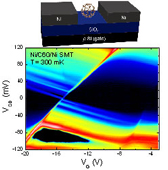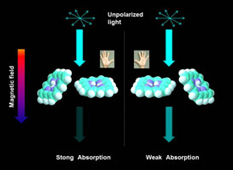Research Topics
Optics and Spintronics

Control of spin wave emission in ferrimagnet
We study the two-dimensional propagation of a spin wave packet excited via the inverse Faraday effect in Bi-doped rare-earth iron garnet. Propagation in two directions, parallel and perpendicular to the magnetic field, was investigated by an all-optical pump-probe experiment. Backward volume magnetostatic waves were detected in both directions. The frequency of BVMSWs depends on propagation direction. The experimental results agreed well with the dispersion relation of backward volume magnetostatic waves.
Tsutomu SHIMURA, Professor, Center Vice Director

Quantum transport in graphene
Graphene is a single-layer honeycomb lattice of carbon atoms, where the charge carrier behave as a relativistic charge carrier, Dirac fermion. We study novel transport phenomena of Dirac fermions in graphene nanostructures, such as single electron tunneling, ballistic transport, and photovoltaic effect due to cyclotron resonance.
Tomoki MACHIDA, Associate Professor
Photonics

Quantum-dot laser technology on silicon
Quantum dot lasers are promising light sources for use in the future electron-photon convergence systems because of their unique characteristics, including high temperature stability and high temperature operations. We are developing quantum-dot lasers on silicon substrates and the corresponding technology for their integration with electronic systems. We have demonstrated a quantum-dot laser on a silicon substrate with a threshold current density of 205 A/cm2, which is currently the lowest reported value for any lasers on silicon.
Yasuhiko ARAKAWA, Professor, Center Director
Satoshi IWAMOTO, Associate Professor

Fundamental research on light sources using group IV and related materials
Light sources using Si, Ge and related group-IV materials, which could be fabricated using CMOS compatible processes, have received increasing attention. We are investigating the fundamental light emission properties of these materials and exploring the control of their light emission by utilizing photonic nanostructures. We have successfully demonstrated Si nanocavity LEDs and Si-based 3D photonic crystal nanocavity lasers using InAs quatum-dot optical gain.
Yasuhiko ARAKAWA, Professor, Center Director
Satoshi IWAMOTO, Associate Professor
Electronics

Fabrication of single molecule transistors and their quantum transport properties
We have fabricated single C60 molecule transistors with ferromagnetic (FM) Ni nanogap electrodes prepared by using ultra-precise electromigration technique. The figure shows their transport properties. The FM/C60 single molecule transistors are one of the important building blocks of molecular spintronics and exhibit large negative tunneling magnetoresistances.
Kazuhiko HIRAKAWA, Professor
Material Science

Plasmon-induced charge separation
Noble metal nanoparticles absorb light due to plasmon resonance. The absorbed energy is used for charge separation in a composite system with the nanoparticles and a semiconductor such as titania. The charge separation can be applied to photovoltaics, photocatalysis, multicolor and infrared photochromism, and photoelectrochemical actuators.
Tetsu TATSUMA, Professor

Magneto-chiral dichroism of organic compounds
Magneto-chiral dichroism (MChD, i.e. the dependence of the absorbance of a chiral molecule on magnetic field directions) is a plausible candidate for explaining the homochirality of life. Using chiral J-aggregates of water-soluble porphyrins, we have demonstrated the presence of MChD in organic compounds for the first time. This finding is also useful for asymmetric synthetic methods and magneto-optical devices.
Kazuyuki ISHII, Professor
Photonics Electronics Convergence

Manipulation of mobile spin coherence using surface acoustic waves
Spin states in semiconductors are expected to act as quantum information carriers in solid state systems. We have demonstrated magnetic-field-free ESR achieved by using spin-orbit interaction of electrons traveling with surface acoustic waves. The technique will provide an efficient and flexible approach for the coherent control of flying spin information in solid-state devices.
Tetsuomi SOGAWA, Visiting Professor
